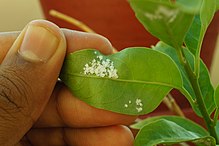
Aphids are small sap-sucking insects and members of the superfamily Aphidoidea. Common names include greenfly and blackfly, although individuals within a species can vary widely in color. The group includes the fluffy white woolly aphids. A typical life cycle involves flightless females giving live birth to female nymphs—who may also be already pregnant, an adaptation scientists call telescoping generations—without the involvement of males. Maturing rapidly, females breed profusely so that the number of these insects multiplies quickly. Winged females may develop later in the season, allowing the insects to colonize new plants. In temperate regions, a phase of sexual reproduction occurs in the autumn, with the insects often overwintering as eggs.
There are a number of lines of defence against pests and diseases in the orchard, principal among these being the practice of good husbandry, creating healthy soil and ensuring high standards of garden hygiene. But no matter how diverse and healthy the garden eco-system may be, there will always be a degree of disease and pest presence. In many ways, some level of pathogen population in the garden can be not only acceptable but desirable as they are indicative of a generally healthful and diverse environment, and add to the overall robustness of the system as an immunity to such detrimental influences will build up, particularly in a balanced polycultural regime. Indeed, most of the plants we grow will tend to be selected because they are trouble free, and those that are more susceptible to attack will have fallen by the wayside over time. However, most farmers find it unacceptable that the food crops they grow are damaged by pests.

Hemiptera is an order of insects, commonly called true bugs, comprising over 80,000 species within groups such as the cicadas, aphids, planthoppers, leafhoppers, assassin bugs, bed bugs, and shield bugs. They range in size from 1 mm (0.04 in) to around 15 cm (6 in), and share a common arrangement of piercing-sucking mouthparts. The name "true bugs" is often limited to the suborder Heteroptera.

The Aphididae are a very large insect family in the aphid superfamily (Aphidoidea), of the order Hemiptera. These insects suck the sap from plant leaves. Several thousand species are placed in this family, many of which are considered plant/crop pests. They are the family of insects containing most plant virus vectors with the green peach aphid being one of the most prevalent and indiscriminate carriers.

Sooty mold is a collective term for different Ascomycete fungi, which includes many genera, commonly Cladosporium and Alternaria. It grows on plants and their fruit, but also environmental objects, like fences, garden furniture, stones, and even cars. The mold benefits from either a sugary exudate produced by the plant or fruit, or honeydew-secreting insects or sap suckers the plant may be infested by.

Honeydew is a sugar-rich sticky liquid, secreted by aphids and some scale insects as they feed on plant sap. When their mouthpart penetrates the phloem, the sugary, high-pressure liquid is forced out of the anus of the aphid. Honeydew is particularly common as a secretion in hemipteran insects and is often the basis for trophobiosis. Some caterpillars of Lycaenidae butterflies and some moths also produce honeydew.

The Sternorrhyncha suborder of the Hemiptera contains the aphids, whiteflies, and scale insects, groups which were traditionally included in the now-obsolete order "Homoptera". "Sternorrhyncha" refers to the rearward position of the mouthparts relative to the head.

The beech blight aphid is a small insect in the order Hemiptera that feed primarily on the sap of American beech trees. The aphids form dense colonies on small branches and the undersides of leaves. A secondary host, based on their geographic location, is the roots of the bald cypress (Taxodium distichum), where some aphids alternate between hosts and others remain with Taxodium distichum year-round.

The black bean aphid is a small black insect in the genus Aphis, with a broad, soft body, a member of the order Hemiptera. Other common names include blackfly, bean aphid, and beet leaf aphid. In the warmer months of the year, it is found in large numbers on the undersides of leaves and on the growing tips of host plants, including various agricultural crops and many wild and ornamental plants. Both winged and wingless forms exist, and at this time of year, they are all females. They suck sap from stems and leaves and cause distortion of the shoots, stunted plants, reduced yield, and spoiled crops. This aphid also acts as a vector for viruses that cause plant disease, and the honeydew it secretes may encourage the growth of sooty mould. It breeds profusely by live birth, but its numbers are kept in check, especially in the later part of the summer, by various predatory and parasitic insects. Ants feed on the honeydew it produces, and take active steps to remove predators. It is a widely distributed pest of agricultural crops and can be controlled by chemical or biological means. In the autumn, winged forms move to different host plants, where both males and females are produced. These mate and the females lay eggs which overwinter.
Pemphigus betae, also known as the sugarbeet root aphid, is a species of gall-forming aphid that forms galls specifically on the commonly found narrowleaf cottonwood, Populus angustifolia. Sugarbeet root aphids have been found in North America and Europe. They infect sugarbeets, but also other plants like tablebeets and Swiss chard. Their size has been likened to that of a pinhead, and are pale white-yellow in color. Sugarbeet root aphids have soft bodies that are bulbous in shape, with mandibular parts that can pierce and suck and paired abdominal tubes that point backwards, and come in both winged and wingless forms. They are known for their consequential effects on agriculture due to infestation of plants, and efforts to control the pests have proved to be difficult.

Aphis craccivora, variously known as the cowpea aphid, groundnut aphid or black legume aphid, is a true bug in the family Aphididae. Originally of probable Palearctic origin, it is now an invasive species of cosmopolitan distribution.

Aphis pomi, commonly known as the apple aphid, or the green apple aphid, is a true bug in the family Aphididae. It is found on young growth of apple trees and on other members of the rose family where it feeds by sucking sap. Reproduction is mainly by parthenogenesis, in which unmated females give birth to live young.

Rhopalosiphum rufiabdominale, the rice root aphid or red rice root aphid, is a sap-sucking insect pest with a wide host range and a global distribution. As a member of the superfamily Aphidoidea, it is one of 16 species of the genus Rhopalosiphum. Adults and nymphs are soft-bodied and usually dark green with brown, red, or yellow tones. Like all aphids, reproduction is sexual and asexual, depending on the environmental conditions and host plant. Rice root aphids cause injury to external plant parts, namely the roots or stem, by feeding on plant sap and vector several important plant viruses. The hosts of this pest extend across multiple plant families with most belonging to Rosaceae, Poaceae, and Solanaceae. R. rufiabdominale is universally associated with Prunus species but also infests various field crops, greenhouse vegetables, cannabis, and other ornamental plants. While this aphid originates from east Asia, it spans nearly every continent. Dispersal is particularly widespread across the United States, India, and Australia, with crop damage documented in multiple instances, although economic losses are primarily associated with Japanese rice crops. Nonetheless, it remains a pest of serious concern due to its high mobility, discrete habitat, and adaptive plasticity, giving it the rightful reputation as a successful invader.

Eriosoma lanigerum, the woolly apple aphid, woolly aphid or American blight, is an aphid in the superfamily Aphidoidea in the order Hemiptera. It is a true bug and sucks sap from plants.
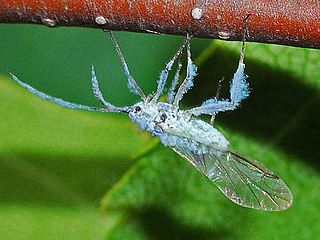
Phyllaphis fagi, the woolly beech aphid, is a species of aphid in the family Aphididae.
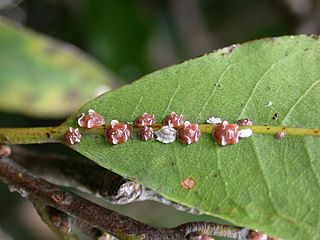
Ceroplastes rubens, known generally as the red wax scale or pink wax scale, is a species of soft scale insect in the family Coccidae. It is native to Australia but has been introduced to other countries, including New Caledonia, Japan, China, Poland and the United States.
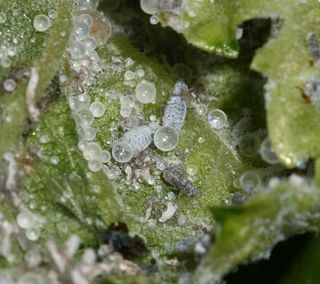
Eriosoma is a genus of true bugs belonging to the family Aphididae.
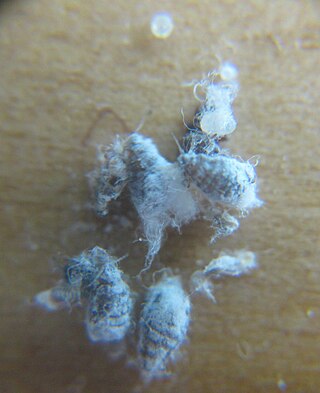
The woolly elm aphid is an aphid native to North America, found where Saskatoon and American elm trees are established.

Eriosoma ulmi, the elm-currant aphid, is a species of aphid in the family Aphididae found in Asia and Europe. It is a true bug and sucks sap from plants. It was described by Carl Linnaeus in his Systema Naturae, published in 1758. The mite causes abnormal plant growths, known as galls on their primary host, elm trees (Ulmus species). To complete there life-cycle they feed on a secondary host, the roots of currant bushes.
